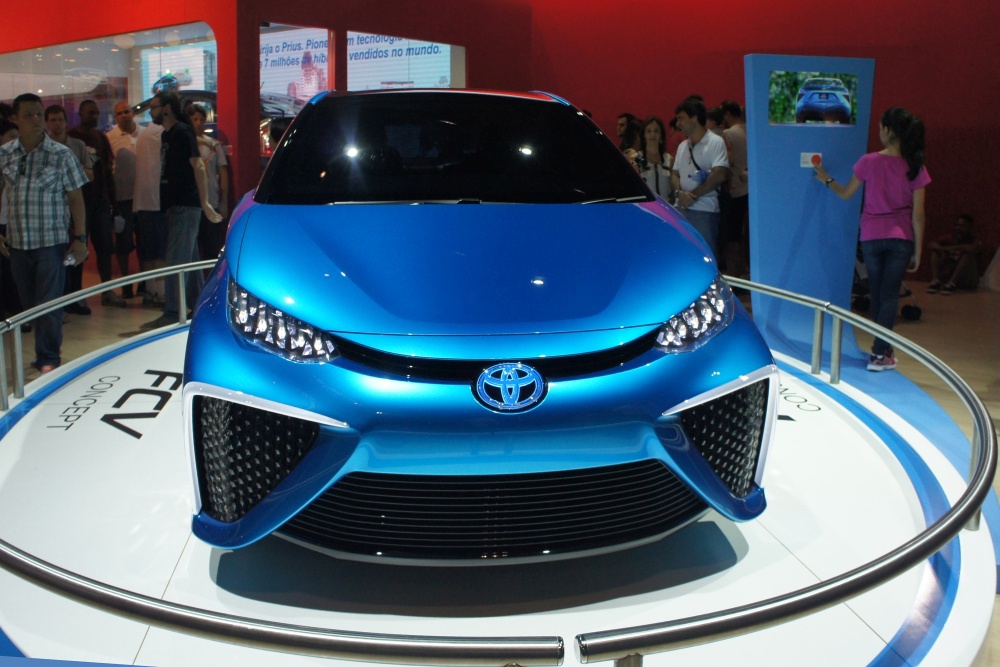Japanese fuel cell sedan
On November 18, the official launch of a new car from Toyota called the Mirai took place . A feature of the car is its energy source - it runs on hydrogen fuel cells. Mirai (Japanese for the future) can travel up to 300 miles (480 km) at one gas station, refuel in less than five minutes, and its exhaust is water vapor. This is a four-door front-wheel drive sedan, similar in size to the Camry.

The car is built on the basis of the prototype FCV fuel car, which was introduced by the company in 2013. The mover is a hybrid unit called FC stack (model FCA110). The reaction with the release of energy occurs without burning. The car also provides energy recovery during braking, which is stored in the secondary battery. The secondary battery is used automatically at high loads (for example, during acceleration). The maximum speed is 175 km / h. An interesting feature is the availability of outlets for powering external consumers. The company says the car will be able to provide energy to the average Japanese home for a week.

Since these cars require special fueling stations, Toyota is working on a project to deploy such stations in the United States together with American partners. So far, in Japan and the United States there are 10 demonstration gas stations. Next year it is planned to collect about 700 cars and begin sales in Japan, Europe and the USA (California). The cost of the car at the beginning of sales will be about $ 57 thousand in Japan and the United States and $ 75 thousand in Europe. The Japanese government plans to subsidize almost $ 20 thousand to sell cars on its territory to support fuel cell vehicles and to build 100 gas stations by 2015. The cost of one refueling is still unknown.

Of the disadvantages of hydrogen-fueled vehicles, the following is worth noting. Firstly, hydrogen is not a source of energy, but only its carrier. For the manufacture of fuel, it is first necessary to expend energy and for the production of fuel requires more energy than it can give. For the production of hydrogen fuel, there is still an electrolysis technology that consumes a lot of energy, or natural gas processing, in which a lot of CO2 is released. Secondly, to store a sufficient amount of energy, hydrogen must be in the tanks under pressure - and it easily leaks out, is very explosive, and also has no color and smell.
The car is built on the basis of the prototype FCV fuel car, which was introduced by the company in 2013. The mover is a hybrid unit called FC stack (model FCA110). The reaction with the release of energy occurs without burning. The car also provides energy recovery during braking, which is stored in the secondary battery. The secondary battery is used automatically at high loads (for example, during acceleration). The maximum speed is 175 km / h. An interesting feature is the availability of outlets for powering external consumers. The company says the car will be able to provide energy to the average Japanese home for a week.

Since these cars require special fueling stations, Toyota is working on a project to deploy such stations in the United States together with American partners. So far, in Japan and the United States there are 10 demonstration gas stations. Next year it is planned to collect about 700 cars and begin sales in Japan, Europe and the USA (California). The cost of the car at the beginning of sales will be about $ 57 thousand in Japan and the United States and $ 75 thousand in Europe. The Japanese government plans to subsidize almost $ 20 thousand to sell cars on its territory to support fuel cell vehicles and to build 100 gas stations by 2015. The cost of one refueling is still unknown.
Of the disadvantages of hydrogen-fueled vehicles, the following is worth noting. Firstly, hydrogen is not a source of energy, but only its carrier. For the manufacture of fuel, it is first necessary to expend energy and for the production of fuel requires more energy than it can give. For the production of hydrogen fuel, there is still an electrolysis technology that consumes a lot of energy, or natural gas processing, in which a lot of CO2 is released. Secondly, to store a sufficient amount of energy, hydrogen must be in the tanks under pressure - and it easily leaks out, is very explosive, and also has no color and smell.
